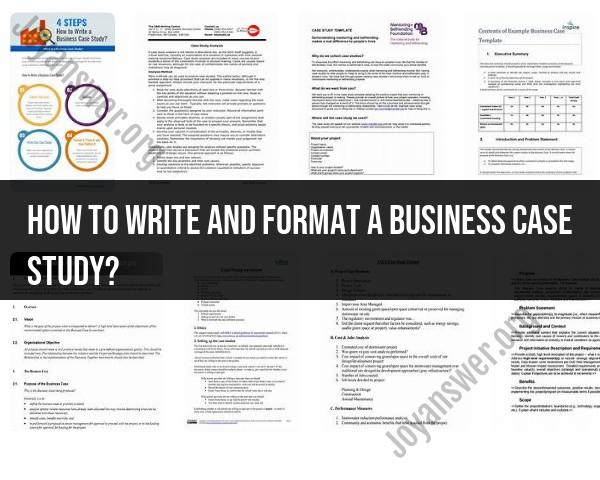How to write and format a business case study?
Writing and formatting a business case study involves presenting a real-world business problem, analyzing it, and providing a solution or recommendations based on the analysis. Here's a step-by-step guide on how to write and format a business case study:
1. Choose a Relevant Topic:
- Select a business-related topic or problem that is interesting, relevant, and can provide valuable insights or lessons.
2. Identify Your Audience:
- Determine the target audience for your case study, whether it's for students, professionals, or a specific industry.
3. Introduction:
- Start with an engaging introduction that provides background information and sets the stage for the case study.
4. Problem Statement:
- Clearly define the problem or challenge the business faced. Be specific and concise.
5. Methodology:
- Describe the research and data collection methods used to analyze the problem. Explain how the data was gathered and analyzed.
6. Presentation of Data:
- Present the relevant data, including charts, graphs, tables, and any supporting evidence. Use visuals to make the information more accessible.
7. Analysis:
- Analyze the data to identify the key issues, trends, and challenges. Discuss the cause and effect relationships that led to the problem.
8. Solutions and Recommendations:
- Propose practical solutions or recommendations based on the analysis. Offer alternatives, if applicable, and explain the potential benefits of each.
9. Implementation Plan:
- Provide a detailed plan for implementing the recommended solutions. Include timelines, responsible parties, and key milestones.
10. Results and Outcomes:- Share the results of implementing the solutions. Discuss any positive outcomes, improvements, or lessons learned.
11. Conclusion:- Summarize the key points and the overall impact of the case study. Reinforce the importance of the lessons learned.
12. References:- Cite all the sources, references, and data used in your case study. Use a consistent citation style (e.g., APA, MLA).
13. Appendices:- Include any additional information that supports your case study but may not be essential in the main body, such as supplementary data or charts.
Formatting Guidelines:
Title: Start with a clear and descriptive title that summarizes the case study.
Font and Style: Use a professional and readable font (e.g., Times New Roman, Arial) and maintain a consistent font size throughout the document (e.g., 12-point).
Headings and Subheadings: Use headings and subheadings to structure the content and make it easy to follow.
Margins and Spacing: Maintain consistent margins (usually 1 inch) and line spacing (e.g., double-spacing).
Page Numbers: Number the pages, typically in the upper right or lower right corner.
Citation Style: Follow a recognized citation style (e.g., APA, MLA, Chicago) for referencing sources.
Length: Case studies can vary in length, but they are typically concise and focused on the key points. However, they should be detailed enough to convey the problem and its resolution effectively.
Visuals: Use visuals to enhance the presentation of data and make the case study more engaging.
Proofreading and Editing: Thoroughly proofread and edit your case study for grammar, spelling, and clarity.
Consistency: Ensure consistent formatting, tone, and style throughout the case study.
Remember that a well-written and formatted business case study can be a valuable tool for learning, decision-making, and sharing insights within an organization or with a wider audience.
What is the structure and format of a business case study?
A business case study is a document that analyzes a specific business situation and recommends a course of action. Business case studies are typically used to persuade decision-makers to support a new project, initiative, or investment.
The structure and format of a business case study will vary depending on the specific situation, but most case studies include the following sections:
- Executive summary: A one-page summary of the entire case study, including the problem, solution, and benefits.
- Introduction: A brief overview of the company, the problem, and the proposed solution.
- Background: A more detailed discussion of the problem, including its history, causes, and impact.
- Analysis: A detailed analysis of the proposed solution, including its benefits, risks, and costs.
- Conclusion: A summary of the key findings and recommendations.
How to choose a compelling and relevant topic for a business case study?
When choosing a topic for a business case study, it is important to consider the following factors:
- Relevance: The topic should be relevant to the audience and to the business goals of the organization.
- Compelling: The topic should be interesting and engaging to the reader.
- Data availability: There should be sufficient data available to support the analysis and conclusions of the case study.
What are the key components of a business case study, including introduction, background, and analysis?
The key components of a business case study are the introduction, background, and analysis.
- Introduction: The introduction should provide a brief overview of the company, the problem, and the proposed solution.
- Background: The background section should provide a more detailed discussion of the problem, including its history, causes, and impact.
- Analysis: The analysis section should provide a detailed analysis of the proposed solution, including its benefits, risks, and costs.
How to gather and present data and evidence effectively in a case study?
When gathering and presenting data and evidence in a business case study, it is important to be clear, concise, and objective. Data and evidence should be presented in a way that is easy to understand and that supports the conclusions of the case study.
Here are some tips for gathering and presenting data and evidence effectively in a business case study:
- Use a variety of data sources, including primary and secondary data.
- Present the data in a clear and concise manner.
- Use data visualization tools to help illustrate the data.
- Be objective in your analysis of the data.
What are best practices for writing a persuasive and informative business case study report?
Here are some best practices for writing a persuasive and informative business case study report:
- Be clear and concise. The case study should be easy to read and understand.
- Be objective. The case study should be based on facts and evidence, not personal opinions.
- Be persuasive. The case study should be written in a way that convinces the reader to support the proposed solution.
- Be informative. The case study should provide the reader with all of the information they need to make a decision.
By following these best practices, you can write a business case study report that is persuasive, informative, and effective.











